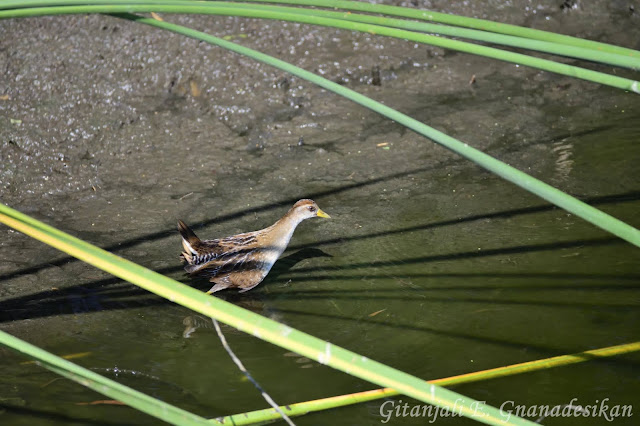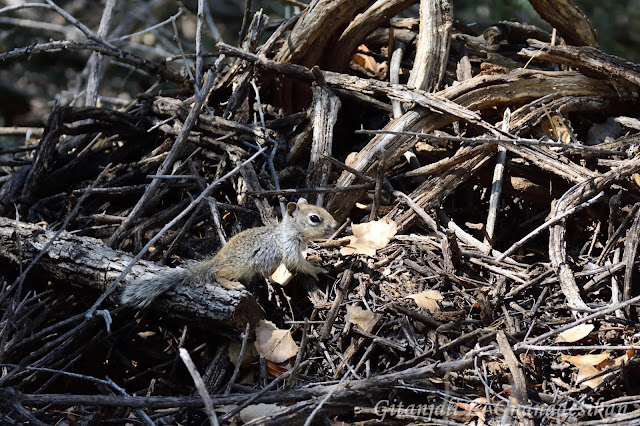Last month I spent a couple hours in Sweetwater Wetlands, a spot I've mentioned before for both the birds and the resident bobcat. It's a constructed wetland and a lovely oasis in the desert. The morning was full of a remarkable variety of beautiful and cute wildlife (including baby rock squirrels, just keep reading!).
Perhaps most notable was this adorable little water bird. I didn't know what it was until I got home and looked it up. It is a sora (Porzana carolina), although I think the lack of black on its face suggests it's a juvenile.
The dragonflies were really stunning, darting about in the sunlight and showing off their lovely jewel tones. Although I took a fair number of blurry photos, I was pleased to get a few good enough to share, including this blue-eyed darner (Rhionaeschna multicolor).
This common green darner has a similar size and shape to the blue-eyed darner, but is—surprise—partly green, and is known as the common green darner (Anax junius). Darners are called darners because their silhouette is said to be a similar shape to a darning needle. Although not all common green darners do so, this species sometimes migrates long distances, especially in the more northerly part of its range; records indicate they can fly up to 122 km (75 mi) in a single day!
I initially misidentified this one as a western pondhawk, but a helpful comment on iNaturalist put me straight. This is a blue dasher (Pachydiplax longipennis), distinguishable by the two pale dots behind the eyes and the rusty color at the base of the hindwings.
This beautifully colored, and aptly named roseate skimmer (Orthemis ferruginea) was also new to me.
There were lots of them buzzing around, and occasionally alighting on things, where it was much easier to get a good photo.
I believe the pink individuals are the males of this species, while the females are orangey-brown.
The butterflies were also lovely. I saw at least one swallowtail, but it was moving far too quickly for me to focus on it. Some of the others were more cooperative, including this queen (Danaus gilippus).
This one is called Empress Leila (Asterocampa leilia), although Google won't tell me why its called that. Another common name for this species is the desert hackberry, as the caterpillars feed on hackberry.
Here's another Empress Leila, perched on a log.
I got a good look at the lovely light blue dots in the middle of the spots on the ventral side of their wings.
I also saw several of these sleepy oranges (Abaeis nicippe) dashing about, but this was the only one I got a good photo of, as it drank some nectar from these little pink flowers.
House finches (Haemorhous mexicanus) are quite common throughout the US, although they are native to the western part of the country and have been introduced in the East. This male (with the red plumage) was looking around curiously...
While these two females perched nearby.
The male red-winged blackbirds (Agelaius phoeniceus) are generally highly visible, as they perch and display, but females like this one can be a little harder to get a good look at.
These common side-blotched lizards (Uta stansburiana) were everywhere, but this one was showing off its side blotch particularly nicely.
The ponds at Sweetwater have quite a sizeable population of red-eared sliders (Trachemys scripta elegans)...
And an overwhelming population of American bullfrogs (Lithobates catesbeianus). You can hardly look in the water, along the edges of the water, or at things sticking up out of the water, without seeing a bullfrog.
They are really quite lovely.... Look at that green and the color and texture of the eye.
This one's a juvenile, with a funny gangly shape.
I really meant it about them being everywhere.
As I walked around the ponds a couple of times, the bullfrogs on the edge of the water, sunning themselves, would be startled by my approach and fling themselves into the water with a bit of a squeak. I tried to capture them in motion, but they're speedy little buggers, and this was as close as I got.
The animals I probably spent the longest time watching—from a respectful distance—were this family of rock squirrels (Otospermophilus variegatus).
I'm honestly not entirely sure how many babies there were. At least five or six, I think. Rock squirrels tend to have two litters a year, one in the spring, and one in August or September, so this was probably her second litter of the year, and they were probably pretty young.
Although the adults of this species are one of the largest members of the squirrel family, the babies were pretty small. It's hard to show just how small with these photos!
That's all for now! I have a backlog of photos from the spring that I'd like to share with you...eventually.





































